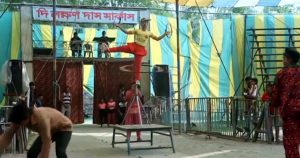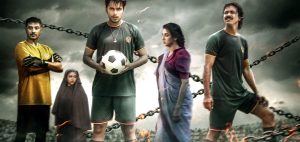A Festival Is The Inauguration Of Consciousness
For Bidhan Rebeiro, certain films touched the hearts of both the audience and the jury. He picks them out here, while also paying tribute to the spirit of the festival.
It would be an understatement to say that the nine days were wonderful because, besides watching all the beautiful films, interacting with film-loving people has left deep traces in my memory. Of course, I am talking about the 21st Dhaka International Film Festival, which started on January 14th and ended on January 22nd. I also got to judge the films this time, like last time. There were two others with me on the FIPRESCI jury: Elena Rubashevskaya from Ukraine and Axel Timo Purr from Germany; both of whom have already excelled in journalism and film criticism.
Our responsibility was to give the FIPRESCI certificate to one full-length film and one short film as the best among the 29 films selected in the Bangladesh Panorama category, besides choosing the first runner-up and second runner-up from the short films. While doing the work, I could highlight Bangladesh’s nature, history, politics, tradition, culture, folk art, literature, economy, religion, etc., to my co-jurors.
Nine full-length and twenty short films of up to ten minutes, the themes of the films were: The liberation war of Bangladesh, the struggle of young people to survive in the city, unemployment, loneliness, the plight of the ordinary peasant family in rural Bangladesh, the relationship of man with nature, the artist’s understanding of art, the performing art like the circus or Performing Arts etc. Although the subjects were familiar to me, my co-jurors enjoyed learning something new from, and also appreciated the narrative style of, these films.
The three of us each made a list of our own preferences before choosing the best. The list included: The Laxman Das Circus, Saatao – Memories of Gloomy Monsoons, Damal, Sin and Virtue (Pap Punya), The Exodus (Deshantor), Bonsai, Haghore – An Era of Homelessness, She (Tei), A Burning Soul (Krishnapaxa), Could You Be Free Yet Locked In?, and The Prize (Puroshkar). For all the films, we had considered the production’s content, container, style, and technical aspects.
The documentary The Laxman Das Circus highlights the life struggles of the people involved in this endangered performing art in Bangladesh, but the film would have gained more depth if it had been taken from any one person or a point of view.
The feature film Damal is based on the independent Bengali football team formed in 1971 during the liberation war of Bangladesh. This film has chosen stories to inspire the youth and walks the path of what is meant by middle cinema. However, it seems incongruous to include love affairs and romantic songs besides the scenes of the independent Bengali football team and a frontal battle in this film wrapped in nationalist spirit.
In the film Sin and Virtue, there are fluctuations like in a Greek tragedy; drama and disaster are enjoyable. But the frequency of events and so many twists make the film unbelievable. On the other hand, the performance of some actors must surely have created more opportunities for future work.
The Exodus tells the story of a family and a relationship torn apart while leaving the country during the Partition. The Partition of India happened in 1947, creating two independent dominions: India and Pakistan. However, such a story is not new. Moreover, the film’s lighting could have been flawless, even though the story is from the Mymensingh area, and the dialect of that area did not come out well in the speaking style of all the actors.
The relationship between man and nature is excellent in the short film Bonsai. However, the scene carrying such plants can be seen in many movies in the country and abroad. The film Haghore – An Era of Homelessness tells the story of a helpless student and a starving street dog in city life during the pandemic. Although the film’s subject is good, the editing could have been more focused.
The film She tells the story of a minor girl, who was trafficked, then comes back and integrates into society. However, there was room to improve the film in various areas, including acting, editing, and lighting. The same suggestion applies to the film The Prize, based on Satyajit Ray’s short story. Finally, the docu-fiction Krishnapaxa highlights Bangladesh’s cinema and theatre crisis. If given a little more technical time, the work would have been better, but still, there was some novelty in presenting the subject in this film.
Competing in the feature-length and short sections respectively, Saatao – Memories of Gloomy Monsoons and Could You Be Free Yet Locked In? both received FIPRESCI certificates. Meanwhile, Saatao actually touched all of our hearts. The crowd-funded film reveals the life struggles of the poor farmers of Bangladesh, the indomitable will to survive, and the motherly nature of human beings against hostile nature and the capitalist society.
On the other hand, in the film Could You Be Free Yet Locked In?, we see an old woman expressing that she wanted to be a photographer in her youth, but due to the pressure of society, it did not become possible any more. The grandson then taught her how to take pictures with a mobile phone. This simple and smooth biographical documentary carries the story of generational sighs, relations and wish fulfillment. Its style of narration is also excellent.
When we announced the names of the winning films on the festival’s closing night, we knew that the films had touched the audience’s hearts because the entire auditorium burst into cheers. Finally, the event ended with the exhibition of the FIPRESCI award-winning film Saatao.
This year I also wrote regularly in the festival bulletin. For nine consecutive days, in nine columns, I have tried to observe the festival from different angles. Moreover, the entire time was spent in joy, gaiety and excitement. Film festivals are a re-opening of consciousness for me.
Bidhan Rebeiro
Edited by Steven Yates
© FIPRESCI 2023


